#doing insectober :]
Explore tagged Tumblr posts
Text
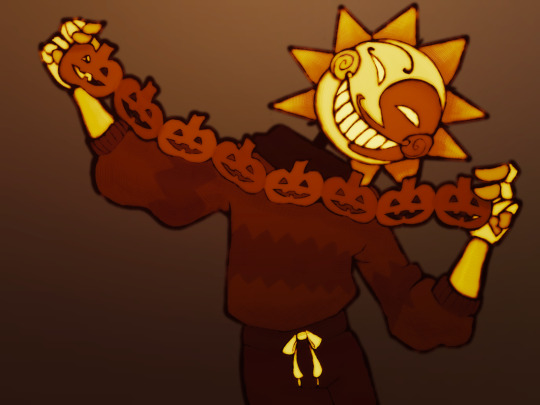
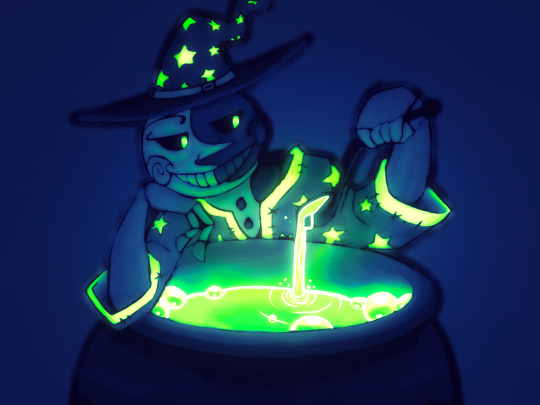
rejoice! halloween themed dca be upon ye
#artists on tumblr#my art#digital art#five nights at freddy's#fnaf security breach#fnaf sb#fnaf sun#fnaf moon#fnaf daycare attendant#🎨#more art coming tomorrow. or later today idk#doing insectober :]
2K notes
·
View notes
Text

Do you know Earwig have angel wings ? They are completly harmless and like to hide in cracks and flowers ♥ #Insectober
4K notes
·
View notes
Text
i'm not in the uk, but i'm closeby in france. here's one baby one i found a couple weeks ago in my garden! i also once saw a lit up female like two years ago? i didn't know they were endangered, and am gonna go log my little one on inaturalist (and i found a similar project for recensing glowworms in france so i'm sending it there too). I am now going to get double as annoying at my whole family about mowing less :3c

Glowworms
(because i keep getting asked about them)
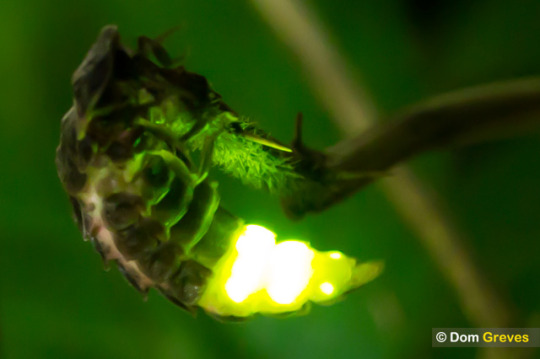
[ID: An adult female glowworm of the species Lampyris noctiluca. It has a bright green glow and clings to a plant.]
Before I even get started, let me lay down some education on the entire Lampyridae family so that we're all on the same page about the specific species that I'm going to talk about for the UK. I've done more research on this topic than the last time I brought it up, and I come bearing knowledge
Lampyridae is a family of beetles, descended from a bio-luminescent ancestor. There are more than 2000 species of Lampyridae, and they can be VERY different. This family is called "fireflies," "glowworms," and "lightningbugs" but ALL of those common names are AWFUL for referring to the full family becaaaaaauuuusee...
Not all lampyridae can fly
Not all lampyridae can glow as adults
Not all lampyridae light up passively; some use it as a lure or a warning
Not all lampyridae light up during flight
In the US, our most iconic species light up during flight, and our most common species have males and females capable of flight. So when I'm talking about "glowworms," remember that those traits are not shared by ALL species of Lampyridae, and especially not this one.
The UK has one species of glowing Lampyridae, Lampyris noctiluca, the Common Glowworm. There's one other, non-glowing species but it's extremely rare and only in the south, and an occasional visitor from mainland Europe.
GLOWWORMS
Only the female lights up, and her final stage is not capable of flight. This is called a "larviform female," because she looks like the wormy adolescent stage that all Lampyridae go through.
The female will climb up to the highest blade of grass she can find and wiggle her butt around until a male, who CAN fly and does NOT glow, finds her. Then she lays eggs and dies.
So because the adults do not eat and quickly die after reproduction, most of a glowworm's life is spent as a larva.
The larval glowworm is a SPECIALIZED predator of gastropods. They hunt snails and slugs for ONE or TWO YEARS (depending on how much food there was in the first year), hibernating over the winter, then waking up and doing it again. All movement in the species is done by the larvae; they have a REALLY hard time establishing new colonies because of this.
This is NOT a pioneer species. You need to have undisturbed grass, moor, or heath, no pesticides, not overgrazed, not brightly lit, for generations of these insects AND their prey. It's REALLY easy to decimate the glowworm population in an area via carelessness.
(let alone the horror story in the Glowworm Survey page where a tiny colony was intentionally destroyed, which is why they have a policy about keeping quiet on reports of certain colonies except to researchers ;_;)
so LOOK AT ME
HOLDING YOU BY THE SHOULDERS
You need to protect glowworm populations when you can. If you ever briefly hear posts in passing shouting about sterile lawns, light pollution, and pesticides, THIS IS WHY. If you live on the island and feel like there's a shit ton of slugs in your garden for some reason? Might be because these factors killed off their specialized predators, leaving you with an unfilled ecological niche.
Environment
Hypothetically, glowworms should be distributed all across Great Britain, except the Scottish highlands, though they have the strongest concentration in southern England.
Functionally, their population is incredibly fragmented. They need tall grass or heather, low light pollution, undisturbed (no pesticide) land, and lots of gastropods to eat. While they can work with forest verges and railways, places for them to thrive are getting rarer and rarer in the UK.
So to restate their very specific environmental needs;
Undisturbed land Glowworms and construction don't mix. Pollution, pesticides, and destruction can destroy the little patches of land glowworms have left. They need up to two years to go from eggs to adults, and a safe place for that to happen in.
A population of gastropods Baby glowworms eat slugs and snails. Because of that, they can't live where it's too dry.
Tall grasses, shrubs, or heathers, but not TOO tall A tree won't do! Glowworms do not live in trees! The females need a tall stalk to climb to the top of, so that they can signal to flying males. At the same time, they can't hunt or find each other in a savanna or a wheat field. Well-managed heathlands are excellent habitat for glowworms.
Low light pollution If it's too bright, males can't find females. Highways with heavy traffic, urban areas, and anything else that gives off constant light will affect the glowworm population.
They glow in June to May, in summer, at night. You won't find glowworms in winter, as all the larvae are hibernating at that time.
BB FAQ
When I determine if something will show up in the Better Bones AU and my Clan Culture expansions, I use iNaturalist to suss out if people are seeing it in the modeled region. Lads, there is a bald spot in my modeled regions. It's almost comical. The closest is in DERBYSHIRE, RIGHT out of reach.
So I'm still unsure about adding them. For now, they are not in BB.
"How do Clan cats feel about them?" They currently have no feelings, as they do not know about them. If they do it will be post-Lake.
"Will you ever add glowworms in the future?" Only if I find out there's a population being reintroduced or discovered in the area. If one of you mad lads adds a sighting to iNaturalist or fills out a report with the UK Glowworm Survey in the modeled regions I'll do it.
"Can you use glowworms to light up the night?" Yes but that's really bad for their populations; leave them be! Clan cats wouldn't use something so holy in such a trivial way.
"Can you eat glowworms?" No they taste really bad. The chemical that makes them light up is REALLY bitter, and it's present in both the larvae and adults. Plus Clan cats wouldn't eat something so holy.
103 notes
·
View notes
Text

While I didn't do inktober (or insectober, like last year) prompts this october, I made up a list of my own! A full 30 creature design prompts tailored to okali for the month of November.
To avoid burnout or loss of motivation, i already have a buffer, and if i still am late on some days beside that, then it'll just spill into december.
Feel free to use the prompt list (or part of it) if it's giving you ideas, if you tag me in art you made using these prompts i'll happily reblog it :)
9 notes
·
View notes
Text
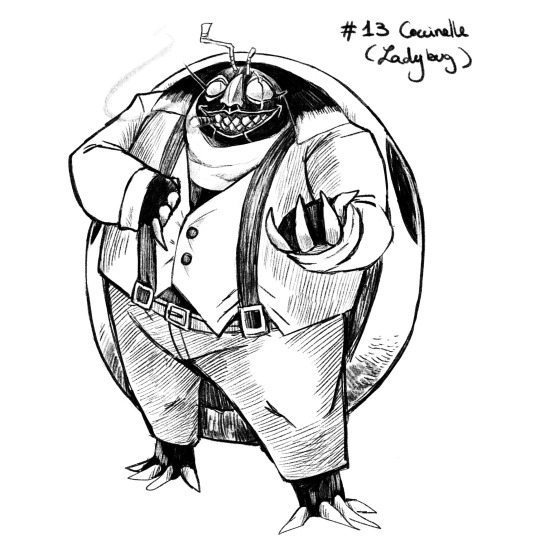
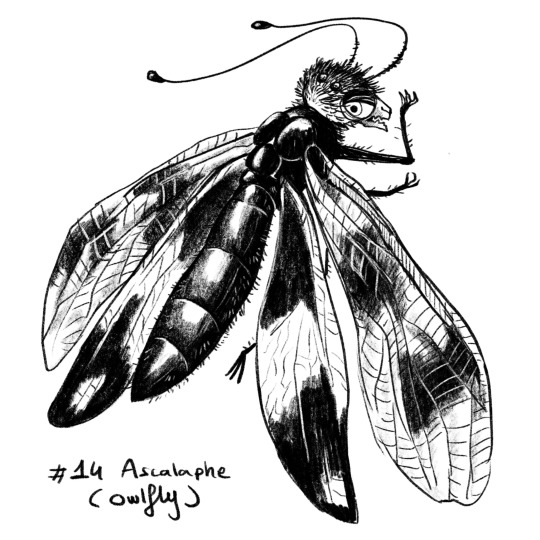
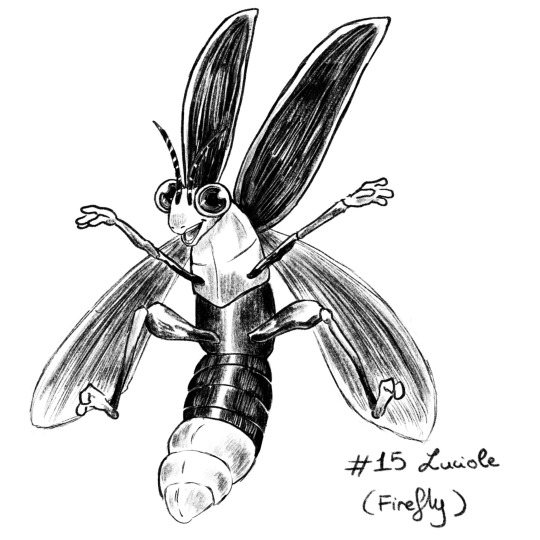
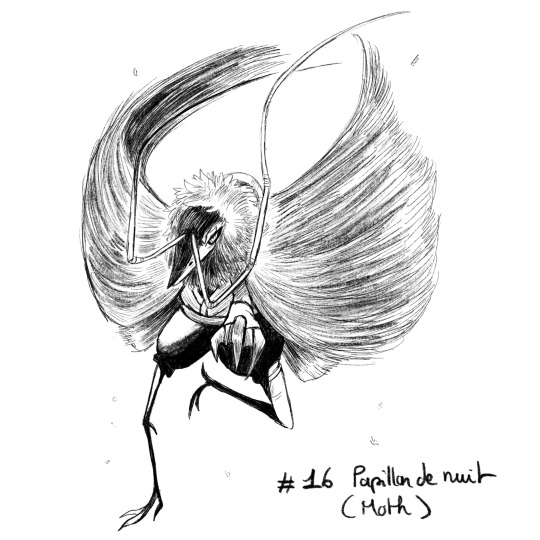

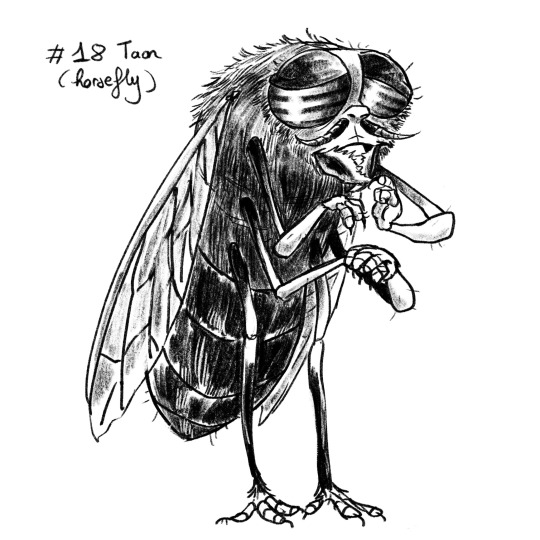
Let’s do an Insectober this year too!
Part 1 - Part 2 - Part 3 - Part 4 - Part 5
—-
Day 13: Ladybug
Day 14: Owlfly
Day 15: Firefly
Day 16: Moth
Day 17: Beetle (Rhinoceros Beetle)
Day 18: Horsefly
290 notes
·
View notes
Text
A Quick Note
I AM gonna do Inktober this year, and I am absolutely going to do better than last year! Yep! Definitely going to last longer than last time.
I’m not going to be working solely from the official prompt list, though - some of them... well the image in my head is currently not something I can recreate xD
One of the lists I’m gonna be drawing from is an insect-based one, all of which I will tag with #insects tw and #insectober, jsyk
3 notes
·
View notes
Text
insectober day 6

The Tsauti is a small but incredibly fast insect. It catches preys in midair with its forelegs, and feeds it to its larvae. The adult drinks nectar for themselves.
They are solitary, only meeting with one another to mate once a year upon exiting hibernation. The female will lay about a dozen eggs over the course of the warm season, and may live up to four years. The males are larvae that hibernated before pupating, and only live one season, they do not hibernate again after becoming adults.
#okali#fantasy#wandering okali#species#art#graphi's things#worldbuilding#speculative biology#specbio#invertober#insectober
25 notes
·
View notes
Text
insectober day 29

The travelling wasp is an insect that lives in large groups, migrating between various altitudes of the Creation Range mountains during the year. They eat nectar pollen, mate, and lay their eggs inside the leaves and stems of a particular host plant; this plant forms a call from which the insect will emerge as an adult.
After becoming an adult and joining its peers, it will first travel to the next location on the journey, then do the same thing as its parents. There are as many as six or seven generations of this insect over a full travel up and down the mountain, and this can be over a period of more than two years. They almost always return to the same spots, where there is a thriving population of their host plant.
#okali#fantasy#wandering okali#species#art#graphi's things#worldbuilding#speculative biology#specbio#invertober#insectober#bugblr
17 notes
·
View notes
Text
insectober day 27

The iefifi is a large insect that's known for its mimicry ; their long shape and markings evoke the young of a species of nudelu common to their area. Due to nudelu, particularlu young, growing ones, being voracious insectivorous predators, this makes other bugs, even ones larger than them, avoid them.
That said, they themselves pose very little threat to much of anything ; they are detritivores, eating carrion, rotting leaves, mulch, things of the sort. Due to their appearance, they are common to see as they rarely bother to do much hiding other than being nocturnal.
#okali#fantasy#wandering okali#species#art#graphi's things#worldbuilding#speculative biology#specbio#insectober#invertober#bugblr
17 notes
·
View notes
Text
insectober day 5

The twin-tailed dustwing; a common generalist, which feeds on various fluids as an adult (it's not picky ; nectar, sweat, juice, blood, urine, you name it). Its larvae, on the other hand, eats food waste.
Due to the larvae's alimentation, finding them inside a house or communal kitchen is often an early sign there's a hygiene problem and scraps aren't cleaned properly.
They're a common compost pile sight as well, and are generally appreciated for their intricate wing patterns. In symbolic okaliss (sorry link from my other blog i need to make an actual post about it on this blog but im doing my best here), they may represent the act of cleaning/removing the last bits of food from the table after a large meal.
#okali#fantasy#wandering okali#species#art#graphi's things#worldbuilding#speculative biology#specbio#invertober#insectober#i was reading my book of insects and i was like#“argh! every bug has the same thing going on everyones eating detritus or plants”#“how am i going to make 31 bugs out of my mind without being repetitive”#SYMBOLISM BABY
15 notes
·
View notes
Text
insectober day 28

The long-legged fishfly is an insect that lives on coasts near the ocean. Its larvae eat the roots of plants that root in sand dunes or gravel, while the adult is a fish ectoparasite.
It preys on fish that find themselves in tidepools, landing on them while they can't easily dive to depths, and using their proboscis to pierce the skin between two scales and suck up blood. Unlike some other closely related species, they do not also supply their diet with nectar ; they are specialized for only blood, and this goes for both sexes.
#okali#fantasy#wandering okali#species#art#graphi's things#worldbuilding#speculative biology#specbio#invertober#insectober#bugblr
15 notes
·
View notes
Text
Insectober day 11

The two-disc fly is a common sight within houses in the mountains of Omikti's Breath. They seek out ripe fruit to lay their eggs on, and once that fruit falls and rots, the larvae will hatch. They eat moldy fruit only ; if it is ripe but does not have mold, they do not start eating.
After growing fat on mold roots, they will bury themselves into the ground, pupate, and the cycle repeats. The adults eat nectar.
Due to the larvae's diet, they are associated with Gormoni and it is considered good luck to gently blow on one if it lands on your finger.
#okali#fantasy#wandering okali#species#art#graphi's things#worldbuilding#speculative biology#specbio#invertober#insectober
7 notes
·
View notes
Text
Insectober day 7

The whistling beetle is a medium-sized (7cm) insect known for the noise they produce.
They are part of a group of beetles that have short adult lifespans where they do not feed, and their mouthparts have been modified into large espodu instead. They make their namesake whistling noise by rubbing their middle legs onto grooves on their elytra, and they touch setae on those legs with their espod to amplify the soundwaves using air magic. Other species in this group use the same technique but make different noises.
Saspi is very fond of this particular species ; they are native to the valley she grew up in, and are what gave her the idea to use air magic as a way to play with sounds.
#okali#fantasy#wandering okali#species#art#graphi's things#worldbuilding#speculative biology#specbio#insectober#invertober
12 notes
·
View notes
Text
insectober day 26

The stilt-legged roach is a small, common insect that lives in trees. It eats mostly fungus growing on the bark, though it also will do with wilted leaves.
To hide from predators, it has evolved an impressive camouflage; it looks like a generic leaf, and can change color slightly to blend in better. These color changes happen over a few days, and they can be spotted the easiest when leaves turn orange and red before falling. Standing on their long legs, they move around in slow movements that imitate those of a leaf in the wind, and their antennae looks like the leaf's stem connecting it to the branch.
#okali#fantasy#wandering okali#species#art#graphi's things#worldbuilding#speculative biology#specbio#bugblr#insectober#invertober
7 notes
·
View notes
Text
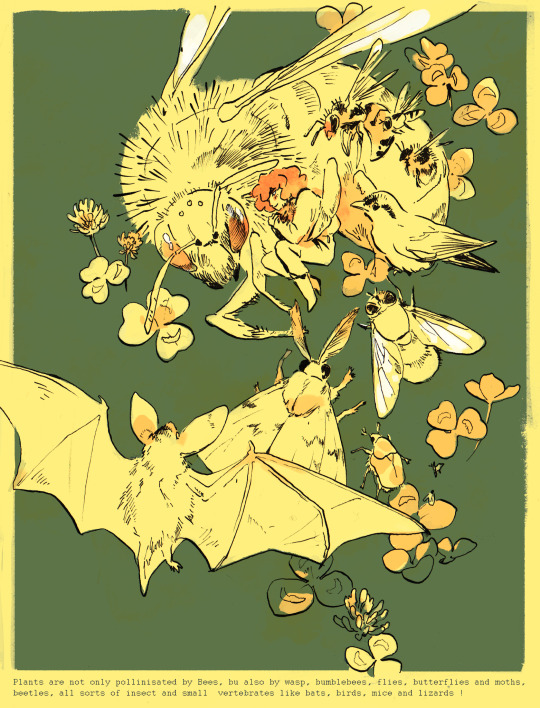
#01 – Pollinators 🌻 They are plenty and diverse ! Plants are not only pollinated by Bees, Bumblebees and Butterflies but also Wasp, Beetles, Flies, Moths, all sort of insect and tiny vertebrates ! Birds, mice, Bats and Lizards are essential to many plant species too. ✨
A soft first drawing for Insectober, comme une Consolation.
Never let anyone make you think you‘re not legitimate to draw what you love. Do it for yourself and have fun, you‘ll find your way.
2K notes
·
View notes
Text

Insectober #6 - Unexpected Predator
Fear not, a Dragonfly will never do any harm to you ! But they WILL eat mosquitoe Larvae and many more. Both the adult Imago and Juvenile form are fearful predators, and therefor play in important role in ecosystems.
Odonates (that's how they're called) are a very ancient order of insects on earth, and probably some of the first to develop the hability to fly. They live and breed next to water, and lay down in it. The juveniles are called Naïades, and leave underwater where they feed on plancton, insects and sometimes even small fish!
106 notes
·
View notes